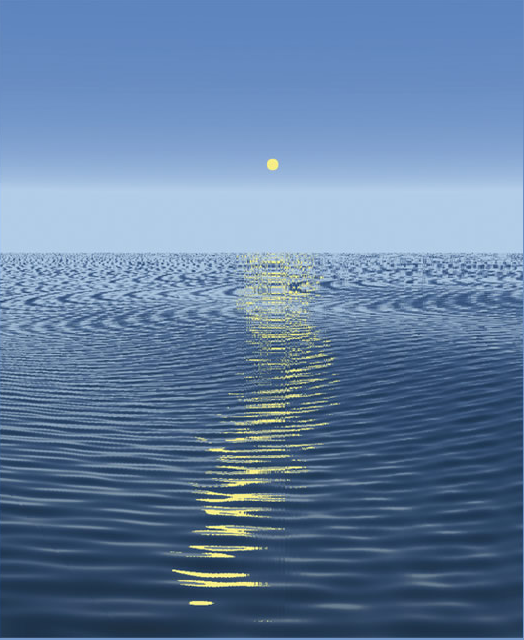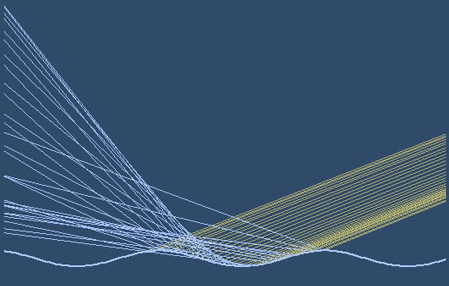OPOD - Bent Glitter Paths
Bent Glitter Paths: A Fascinating Phenomenon in Atmospheric Optics
Glitter paths, those mesmerizing patches of sunlight or moonlight reflected on water, are typically seen as straight lines. However, there are instances when these glitter paths appear bent, creating a captivating visual effect. One such occurrence was captured off the Norwegian Coast by David Lynch, a renowned expert in atmospheric optics and co-author of the book "Color & Light in Nature." In this article, we delve deeper into the science behind these bent glitter paths and explore the various factors that contribute to their formation.
According to Lynch, the symmetry of glitter paths is usually preserved, with the glitter being symmetric about a vertical line running down its axis. However, there are occasions when the glitter appears bent, with a portion of it offset from the vertical. This peculiar phenomenon is a result of waves with asymmetric transverse profiles, meaning they have uneven slopes from left to right relative to the vertical axis.
One possible explanation for bent glitter paths involves the interaction between short-wavelength glitter-producing waves and a long wavelength wave. When a field of short-wavelength waves is overtaken by a long wavelength wave, the shorter waves become tilted on average. As a result, the distribution of wave slopes is shifted in one direction, causing the glitter to appear offset from the vertical axis. An example of this can be observed when the long bow wave of a ship moves into a field of glitter.
Another factor contributing to the formation of asymmetric wave slopes is wind action. When wind blows across water, it generates waves of varying wavelengths, starting with short capillary waves often referred to as "cat's paws." Over time, these waves build up, leading to longer wavelengths. The combination of these waves with different slopes can create an environment conducive to the formation of bent glitter paths.
To further understand and simulate the phenomenon of bent glitter paths, Lynch and his colleague David Dearborn developed a computer program capable of predicting the shape of glitter based on an arbitrary wave slope distribution and the sun's elevation. By skewing the waves in the foreground, they were able to reproduce bent glitter paths that closely resemble the captivating image captured off the Norwegian Coast.
The study conducted by Lynch, Dearborn, and Lock, titled "Glitter and Glints on Water," provides valuable insights into the complexities of glitter paths and unveils new findings related to this optical phenomenon. Published in Applied Optics in 2011, the research expands our understanding of the intricate interplay between waves, sunlight, and the resulting glitter patterns observed on water surfaces.
Glitter paths, despite their seemingly simple description, exhibit remarkable subtleties. Under certain conditions, the reflected light forms caustic sheets, which are areas of concentrated brightness on the water's surface. As wave motion sweeps these sheets across our field of vision, we perceive a rapid succession of bright flashes. These flashes then split into two spots that dance around until they ultimately converge and recombine in another flash. The speed at which these events occur can often surpass the eye's ability to track them individually, leading us to perceive the dance of spots as a series of closed loops. This intricate visual dance is influenced by a branch of pure mathematics known as "catastrophe theory," which finds applications in describing caustics and water glint effects.
In conclusion, bent glitter paths offer a captivating glimpse into the complexities of atmospheric optics. The interplay between waves, sunlight, and wind action contributes to the formation of these intriguing phenomena. By studying and simulating these bent glitter paths, researchers like David Lynch and David Dearborn deepen our understanding of the underlying mechanisms at play. Their work sheds light on the intricate dynamics of glitter paths and expands our knowledge of the beautiful and ever-changing world of atmospheric optics.


Bent Glitter Path
Glitter paths usually come straight. This unusual bent one was captured off the Norwegian Coast by David Lynch, co-author of Color & Light in Nature (Now back in print! Available here).
©David Lynch, shown with permission.
David Lynch writes: "Glitter is that bright patch of sunlight (or moonlight) reflected on water. It can take various forms depending on the wave slopes and sun elevation, but in almost all cases the glitter is symmetric about a vertical line running down its axis.
From time to time, however, the glitter appears �bent�, with part of it offset from the vertical. Such features are the result of waves whose transverse profiles (left-right relative to vertical) are asymmetric.
One possible way is to have a field of short wavelength glitter-producing waves overtaken by a long wavelength wave. This causes the short-wavelength waves to be tilted one way or the other on average. As a result, the wave slope distribution is shifted in one direction, thereby shifting the glitter sideways. This is the case at left where the long bow wave of a ship moves into a field of glitter.
Another way to produce asymmetric wave slopes is with wind action. Wind blowing across water will produce all wavelengths of waves, starting with short waves (capillary waves��cat�s paws�) and building up to longer wavelengths as time goes on.
To simulate bent glitter, David Dearborn and I wrote a computer program that predicts the shape of glitter for an arbitrary wave slope distribution and sun elevation. By skewing the waves in the foreground, we were able to produce bent glitter that resembles the image at top."
The work, plus other new glitter findings, is published in:
Lynch, D. K., D.S.P. Dearborn, J.A. Lock �Glitter and Glints on Water�, Applied Optics, 50, F39-F49 (2011)

Glitter paths are the collective glints of sunlight reflected from the curved and ever changing surface of wavy water.
That description belies their considerable subtleties. Under many conditions the reflected light forms caustic sheets. As wave motion sweeps a sheet across the eye it sees a bright flash on the water surface. The flash then splits into two spots that dance around until they eventually find one another and recombine in another flash. All that can be too fast for the eye to follow and then we see the dance of the spots as one of many closed loops. A comparatively recent branch of pure mathematics �catastrophe theory� has many applications to the descriptions of caustics and water glint effects.
Note: this article has been automatically converted from the old site and may not appear as intended. You can find the original article here.
Reference Atmospheric Optics
If you use any of the definitions, information, or data presented on Atmospheric Optics, please copy the link or reference below to properly credit us as the reference source. Thank you!
-
<a href="https://atoptics.co.uk/blog/opod-bent-glitter-paths/">OPOD - Bent Glitter Paths</a>
-
"OPOD - Bent Glitter Paths". Atmospheric Optics. Accessed on April 24, 2024. https://atoptics.co.uk/blog/opod-bent-glitter-paths/.
-
"OPOD - Bent Glitter Paths". Atmospheric Optics, https://atoptics.co.uk/blog/opod-bent-glitter-paths/. Accessed 24 April, 2024
-
OPOD - Bent Glitter Paths. Atmospheric Optics. Retrieved from https://atoptics.co.uk/blog/opod-bent-glitter-paths/.